-
ORIGINAL ARTICLE12-16-2024
Editorial discourses in the history of Acta Paulista de Enfermagem (1988-2017)
Revista Brasileira de Enfermagem. 2024;77(6):e20230362
Abstract
ORIGINAL ARTICLEEditorial discourses in the history of Acta Paulista de Enfermagem (1988-2017)
Revista Brasileira de Enfermagem. 2024;77(6):e20230362
DOI 10.1590/0034-7167-2023-0362
Views0See moreABSTRACT
Objectives:
to analyze the editorial discourses of Acta Paulista de Enfermagem from 1988 to 2017.
Methods:
qualitative, historical, oral research, with interviews with the journal’s editors. Statements were categorized and presented in three decades, discussed from Foucault’s archaeological perspective.
Results:
seven statements presented three discourses. In the first decade, the discourse of knowledge registration and circulation presented statements of graduate studies and professional recognition. In the second decade, knowledge internationalization was added, with statements of business and editorial panopticism, selection criteria, indexing and digitalization. Finally, the discourse of shifting scientific assessment centrality was added with statements of preprint, open science, exclusive digitalization and mediatization of science.
Final Considerations:
the journal needed to adapt to form its official discourse, which made it possible, over the years, to change its initial peripheral position to a central one within scientific communication, supporting its panoptic role.
-
REVIEW12-16-2024
Strategies for expanding vaccination coverage in children in Brazil: systematic literature review
Revista Brasileira de Enfermagem. 2024;77(6):e20230343
Abstract
REVIEWStrategies for expanding vaccination coverage in children in Brazil: systematic literature review
Revista Brasileira de Enfermagem. 2024;77(6):e20230343
DOI 10.1590/0034-7167-2023-0343
Views1See moreABSTRACT
Objectives:
to identify the strategies found in the literature for increasing vaccination coverage among children in Brazil. It is justified mainly by the current scenario of falling vaccination coverage.
Methods:
systematic literature review. The search was carried out in the Pubmed (MEDLINE), Embase and Scopus databases, following the PRISMA guidelines.
Results:
initially, 4,824 results were returned. In the end, 6 studies were included for narrative synthesis using the SWiM methodology. Of these, 50% dealt with studies related to the Bolsa Família Program (PBF). The others explored strategies for approaching parents directly, Rapid Vaccination Monitoring (MRV) and the Community Health Agents Program (PACS). The PBF did not guarantee compliance with the conditionality of keeping vaccinations up to date. The MRV and PACS are effective strategies, especially because they allow active search for absentees.
Conclusions:
we conclude that more publications are needed on strategies to increase vaccination coverage among children in Brazil.

-
ORIGINAL ARTICLE12-16-2024
Educational technology to empower patients as participants in their care
Revista Brasileira de Enfermagem. 2024;77(6):e20230359
Abstract
ORIGINAL ARTICLEEducational technology to empower patients as participants in their care
Revista Brasileira de Enfermagem. 2024;77(6):e20230359
DOI 10.1590/0034-7167-2023-0359
Views0See moreABSTRACT
Objectives:
to build and validate an educational technology to empower patients as participants in their own care.
Methods:
methodological study to develop an educational technology based on the elaboration, validation, and evaluation that were carried out in five stages at a teaching hospital in Amazonas. The study was carried out from 2019 to 2022, with the participation of 19 judges specialized in patient safety and 72 patients admitted to the hospital’s medical and surgical clinics, the study setting.
Results:
the agreement between the judges obtained an overall index of 0.85, being considered validated. The overall analysis of the booklet obtained an assessment of the level of agreement above 85%.
Final Considerations:
the educational technology presented here was validated and suitable for promoting patient/professional rapprochement and consolidating health care in a way that increases the patient’s ability to contribute to their treatment and prevent the occurrence of adverse events.
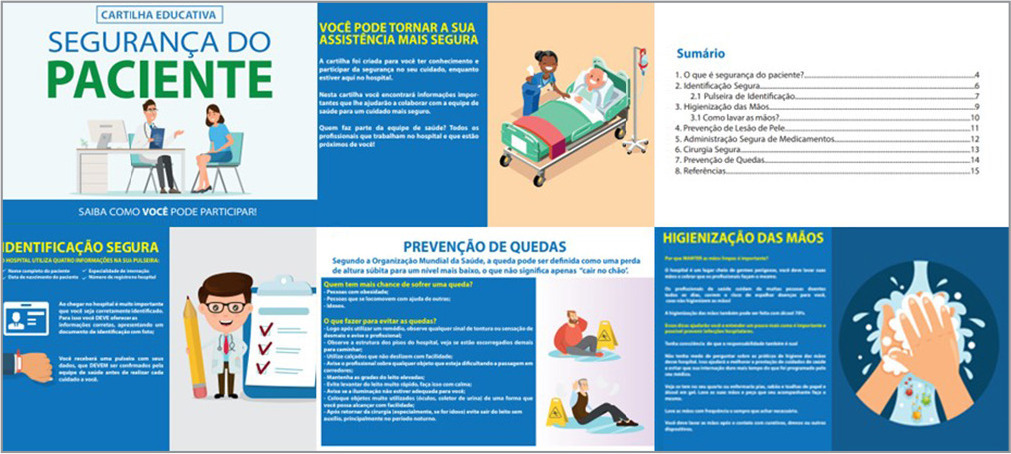
-
ORIGINAL ARTICLE12-13-2024
Educational booklet on labor and delivery: validity study
Revista Brasileira de Enfermagem. 2024;77(5):e20240138
Abstract
ORIGINAL ARTICLEEducational booklet on labor and delivery: validity study
Revista Brasileira de Enfermagem. 2024;77(5):e20240138
DOI 10.1590/0034-7167-2024-0138
Views2See moreABSTRACT
Objectives:
to develop and validate an educational booklet on labor and delivery for pregnant women.
Methods:
this methodological study involved constructing and validating a booklet based on Echer’s framework. We used the Content Validity Index and Cronbach’s alpha for content and face validation, selecting judges according to Fering’s criteria. We then conducted a clinical validation with the target population.
Results:
the booklet, developed based on evidence from an integrative review and validated by judges and the target audience, achieved global Content Validity Index of 0.919 and 0.913, respectively. After clinical validation with 22 pregnant women, it included 28 topics and 48 pages, with illustrations by a graphic designer.
Conclusions:
expert judges and the target audience considered this educational technology valid, deeming it a relevant tool for promoting the health of pregnant women.
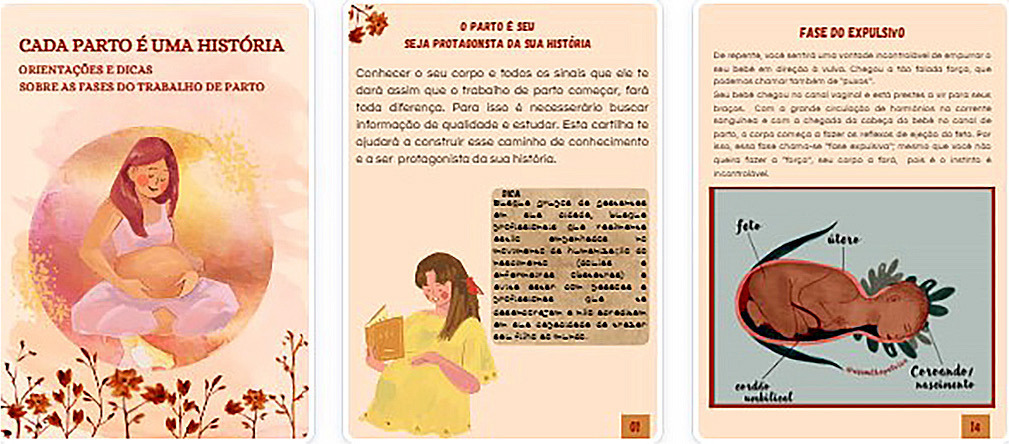
-
ORIGINAL ARTICLE12-13-2024
Interobserver agreement in Reception and Risk Stratification in Obstetrics implementation
Revista Brasileira de Enfermagem. 2024;77(5):e20230361
Abstract
ORIGINAL ARTICLEInterobserver agreement in Reception and Risk Stratification in Obstetrics implementation
Revista Brasileira de Enfermagem. 2024;77(5):e20230361
DOI 10.1590/0034-7167-2023-0361
Views0See moreABSTRACT
Objectives:
to analyze interobserver agreement in the Reception and Risk Stratification in Obstetrics protocol implementation.
Methods:
a cross-sectional study carried out during Reception and Risk Stratification in Obstetrics implementation, conducted in a tertiary hospital in southern Brazil with 891 participants in January 2020. Descriptive and interobserver agreement analysis was carried out using the Kappa coefficient in the risk stratification assigned by the triage nurse and reviewed by the researcher.
Results:
around half of the calls (55.6%) were stratified as not very urgent (green), followed by urgent (yellow) (31.8%), very urgent (orange) (9.3%), not urgent (blue) (3.4%) and no emerging stratification (red). Agreement analysis of revised stratification found Kappa values of 0.20 (blue), 0.54 (green), 0.77 (yellow) and 0.80 (orange).
Conclusions:
most appointments were non-urgent. The agreement analysis between the revised and assigned risk stratification revealed greater interobserver agreement as the priority level increased.
-
12-13-2024
Training of Brazilian indigenous nurses: between human rights, valuing diversity and inclusion
Revista Brasileira de Enfermagem. 2024;77(5):e20230430
Abstract
Training of Brazilian indigenous nurses: between human rights, valuing diversity and inclusion
Revista Brasileira de Enfermagem. 2024;77(5):e20230430
DOI 10.1590/0034-7167-2023-0430
Views0See moreABSTRACT
Objectives:
to analyze the possibilities and potential of training indigenous nurses, given the Brazilian Health System (SUS), understanding the relationships between education and health.
Methods:
theoretical-reflective study, based on scientific literature, aligned with the experience, critical thinking of its authors and the Sustainable Development Goals in Brazil.
Results:
this text articulates three axes: Potential for including indigenous students in nursing training; Paths to achieving equity through inclusion and retention policies for indigenous students at different levels; and Implications of this for the SUS and global health.
Final Considerations:
indigenous students, beneficiaries of affirmative actions, face challenges of inclusion and retention in public universities that directly impact their academic training. Added to this are the difficulties identified in basic education, professor training and implementation of permanence policies, with consequences for services and training at other levels.
-
ORIGINAL ARTICLE12-13-2024
Stress in nursing workers caring for people with COVID-19
Revista Brasileira de Enfermagem. 2024;77(5):e20230542
Abstract
ORIGINAL ARTICLEStress in nursing workers caring for people with COVID-19
Revista Brasileira de Enfermagem. 2024;77(5):e20230542
DOI 10.1590/0034-7167-2023-0542
Views1See moreABSTRACT
Objectives:
to analyze stress from the perspective of nursing workers caring for people with COVID-19 in a public hospital in the Recôncavo region of Bahia.
Methods:
this is an exploratory qualitative study, conducted through semi-structured interviews. The data were analyzed using word clouds, similarity trees, and content analysis.
Results:
nursing workers were exposed to stress while attending to patients with COVID-19. The reported stressors in the workplace included: work overload, lack of planning, speed in performing tasks, fatigue, lack of participation in decision-making, lack of support from management, technological changes, excessive responsibility without preparation, interpersonal conflicts, and professional undervaluation.
Conclusions:
exposure to these stressors leads to emotional exhaustion and demotivation, which were intensified during the COVID-19 pandemic.
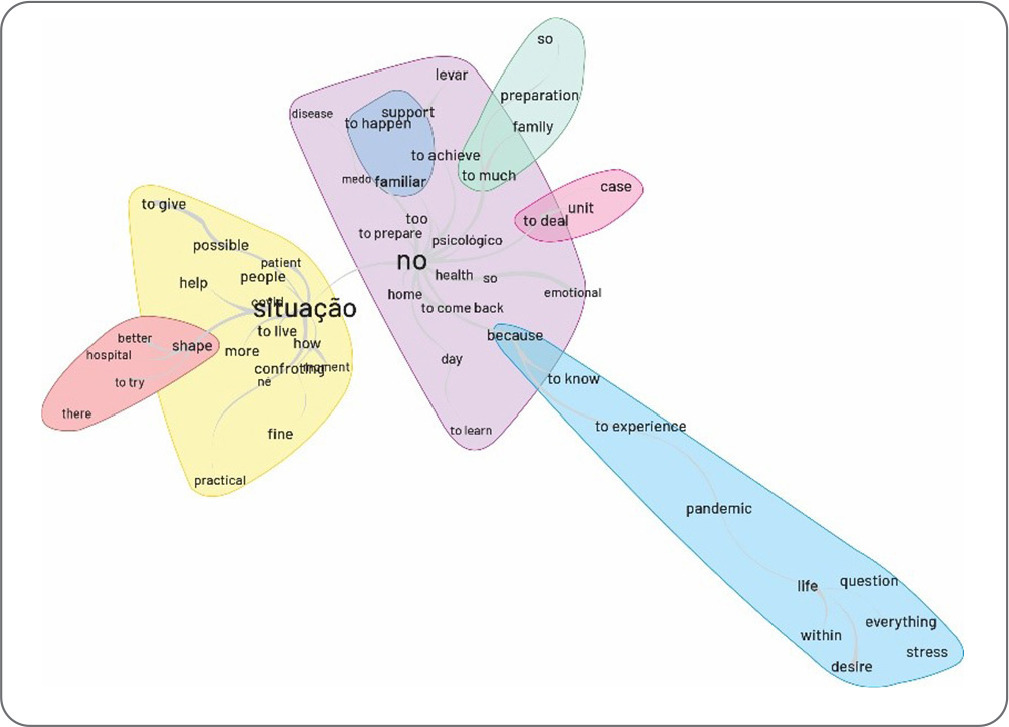
-
ORIGINAL ARTICLE12-13-2024
Adaptation and implementation of a Nursing care protocol for children in the Amazon Region
Revista Brasileira de Enfermagem. 2024;77(5):e20230245
Abstract
ORIGINAL ARTICLEAdaptation and implementation of a Nursing care protocol for children in the Amazon Region
Revista Brasileira de Enfermagem. 2024;77(5):e20230245
DOI 10.1590/0034-7167-2023-0245
Views0See moreABSTRACT
Objectives:
to describe the process of implementing an adapted protocol for pediatric nursing care in a health unit located in a municipality in the Amazon Region.
Methods:
methodological research conducted in a basic health unit with four family health teams in the state of Rondônia, involving seven nursing professionals. Data collection occurred between October 2020 and April 2022, following the research phases: situational diagnosis, exploratory phase, protocol definition, implementation, and evaluation.
Results:
the outcome was the adaptation and implementation of a nursing care protocol for children.
Final Considerations:
the adaptation and implementation process can be an effective approach to improving care, strengthening nursing as a profession with a solid foundation in scientific and clinical evidence. This facilitates early problem identification and appropriate guidance, leading to better health outcomes for children.
-
ORIGINAL ARTICLE09-07-2020
Construction of the matrix of individual nursing competences in surgical units
Revista Brasileira de Enfermagem. 2020;73(6):e20190584
Abstract
ORIGINAL ARTICLEConstruction of the matrix of individual nursing competences in surgical units
Revista Brasileira de Enfermagem. 2020;73(6):e20190584
DOI 10.1590/0034-7167-2019-0584
Views0See moreABSTRACT
Objective:
to build and to describe an Individual Skills Matrix for nurses working in surgical units and their associated behaviors / attitudes.
Method:
Exploratory, qualitative study. 43 nurses from five surgical units participated, and data collection was carried out between April and September 2017. The focus group technique was used and for data interpretation an inductive thematic analysis was performed. The competence matrix was built from the testimonies of the participants plus a search in the literature for concepts directed to each competence and description of the expected behaviors and / or attitudes.
Results:
For the Matrix, the following individual skills were identified: Planning; Communication, Relational Competence, Leadership, Decision Making and Ethics.
Final Considerations:
The construction of a Matrix should assist managers in recognizing the professional profile and assessing their performance, strengthening the achievement of professional and organizational objectives, as well as contributing to the quality and effectiveness of the care provided by nurses in these places.
-
EXPERIENCE REPORT02-10-2020
Mental health in primary care: experience of matrix strategy in the rural area
Revista Brasileira de Enfermagem. 2020;73(1):e20180236
Abstract
EXPERIENCE REPORTMental health in primary care: experience of matrix strategy in the rural area
Revista Brasileira de Enfermagem. 2020;73(1):e20180236
DOI 10.1590/0034-7167-2018-0236
Views0See moreABSTRACT
Objective:
to report the development of Mental Health actions shared between the Family Health Strategy located in a rural area and the Matrix Support Team by showing the communication resulting from this singular configuration.
Method:
report of experience about the implementation of actions of the Family Health Support Center (Portuguese acronym: NASF) in mental health care for a rural population.
Results:
the following health needs were identified: psychoactive drugs consumption, lack of activities for collective care and difficulty with access to service. The expansion of actions and intersectoral involvement of actors were demonstrated as the educational attitudes were implemented.
Final considerations:
the articulation between family health workers, matrix support and community was key for the implementation of mental health care aligned with the psychosocial approach.
-
ORIGINAL ARTICLE11-29-2022
Scenario validation for clinical simulation: prenatal nursing consultation for adolescents
Revista Brasileira de Enfermagem. 2022;75(3):e20200791
Abstract
ORIGINAL ARTICLEScenario validation for clinical simulation: prenatal nursing consultation for adolescents
Revista Brasileira de Enfermagem. 2022;75(3):e20200791
DOI 10.1590/0034-7167-2020-0791
Views0See moreABSTRACT
Objectives:
to validate a scenario for clinical simulation: prenatal nursing consultation for adolescents.
Methods:
methodological study developed from January to December 2019, in five stages (overview, scenario, scenario design, progression, debriefing and assessment). The validation involved four volunteer students, a teacher as a facilitator and four judges. The judges filled out a Likert scale with four responses. Data was analyzed using Microsoft Excel® software, version 2016. Absolute and relative frequencies and the content validity index were calculated, considering a minimum acceptable value of 1.0.
Results:
the preparation of the scenario was based on the proposed learning objectives. The scenario was validated with a global content validity index equal to 1.0.
Final Considerations:
the study achieved the proposed objective. This scenario can contribute to preparing nurses to work in the care of pregnant teenagers, a representative public in Brazil that requires specific care.

-
05-21-2021
Term database for nursing practice in the context of coronavirus (COVID-19) infections
Revista Brasileira de Enfermagem. 2021;74:e20200703
Abstract
Term database for nursing practice in the context of coronavirus (COVID-19) infections
Revista Brasileira de Enfermagem. 2021;74:e20200703
DOI 10.1590/0034-7167-2020-0703
Views0See moreABSTRACT
Objective:
to build a term database relevant to nursing practice in the context of COVID-19 infections.
Methods:
this is a methodological, documentary study, carried out from March to June 2020 at ICNP®/ Universidade Federal da Paraíba center, considered a reference for research and dissemination of ICNP® in Brazil. The findings were collected in databases and analyzed using the PorOnto tool, the consensus technique and the mapping of terms with ICNP®, version 2019/2020.
Results:
1,134 relevant terms were identified in literature. When submitted to the mapping technique with the terms of ICNP® Seven Axis Model, it resulted in 531 constant terms and 603 nonconstant terms in this classification.
Final considerations:
It is proven that nursing practice terms, even in a specific context, are present in the literature and are representative in ICNP®, which will enable the future development of a terminological subset in the context of coronavirus infections.
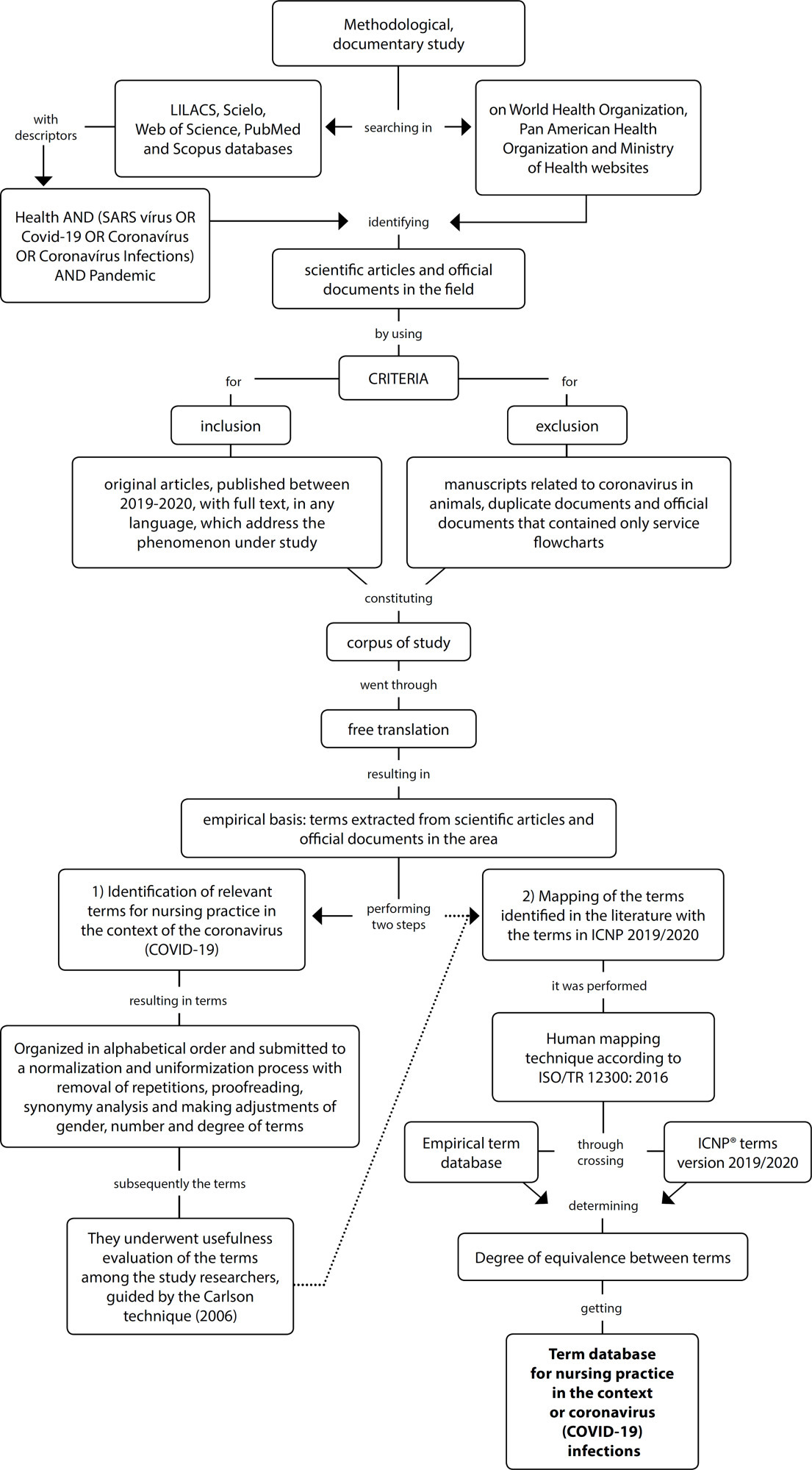
-
ORIGINAL ARTICLE01-14-2022
Hospital structure elements demarcating (in)visibilities of institutional violence against children
Revista Brasileira de Enfermagem. 2022;75:e20200785
Abstract
ORIGINAL ARTICLEHospital structure elements demarcating (in)visibilities of institutional violence against children
Revista Brasileira de Enfermagem. 2022;75:e20200785
DOI 10.1590/0034-7167-2020-0785
Views0See moreABSTRACT
Objectives:
to analyze the hospital structure elements that demarcate (in)visibilities of institutional violence in hospitalized children.
Methods:
this is a descriptive-exploratory qualitative study that used approaches with Foucault’s thinking. Ten companions and 39 healthcare professionals from a university hospital in Salvador, Bahia participated. Data collection took place from November 2018 to June 2019 through semi-structured interviews. The discourse analysis method was used. The study was approved by the Institutional Review Board.
Results:
institutional violence was understood in the violations and invisibilities of the structure of health services through the problems: in infrastructure (physical structure, lack of human and material resources, scrapping of equipment); administrative and management; pilgrimage.
Final Considerations:
it is necessary to realize the invisibilities of the infrastructure to act in confronting institutional violence to hospitalized children.
-
ORIGINAL ARTICLE05-21-2021
Good Practices in Transitional Care: continuity of care for patients undergoing liver transplantation
Revista Brasileira de Enfermagem. 2021;74(2):e20200746
Abstract
ORIGINAL ARTICLEGood Practices in Transitional Care: continuity of care for patients undergoing liver transplantation
Revista Brasileira de Enfermagem. 2021;74(2):e20200746
DOI 10.1590/0034-7167-2020-0746
Views0See moreABSTRACT
Objectives:
to develop a guide of care recommendations for good practices in care transition for adult patients undergoing liver transplantation.
Methods:
a methodological study, based on the Appraisal of Guidelines for Research & Evaluation in the updated version, II. Care recommendations were sustained by conducting an integrative literature review and qualitative research.
Results:
from evidence, three topics emerged: Care Transition Planning; Health Education for Self-Care; Care Management. Each of the central topics has respective subtopics, totaling six, giving rise to 30 care recommendations. Concerning evaluators’ scores, in all domains the scores were higher than 90%.
Final Considerations:
the proposed guide assists professionals in conducting care transition in liver transplantation, ensuring greater safety for patients in continuity of home care.
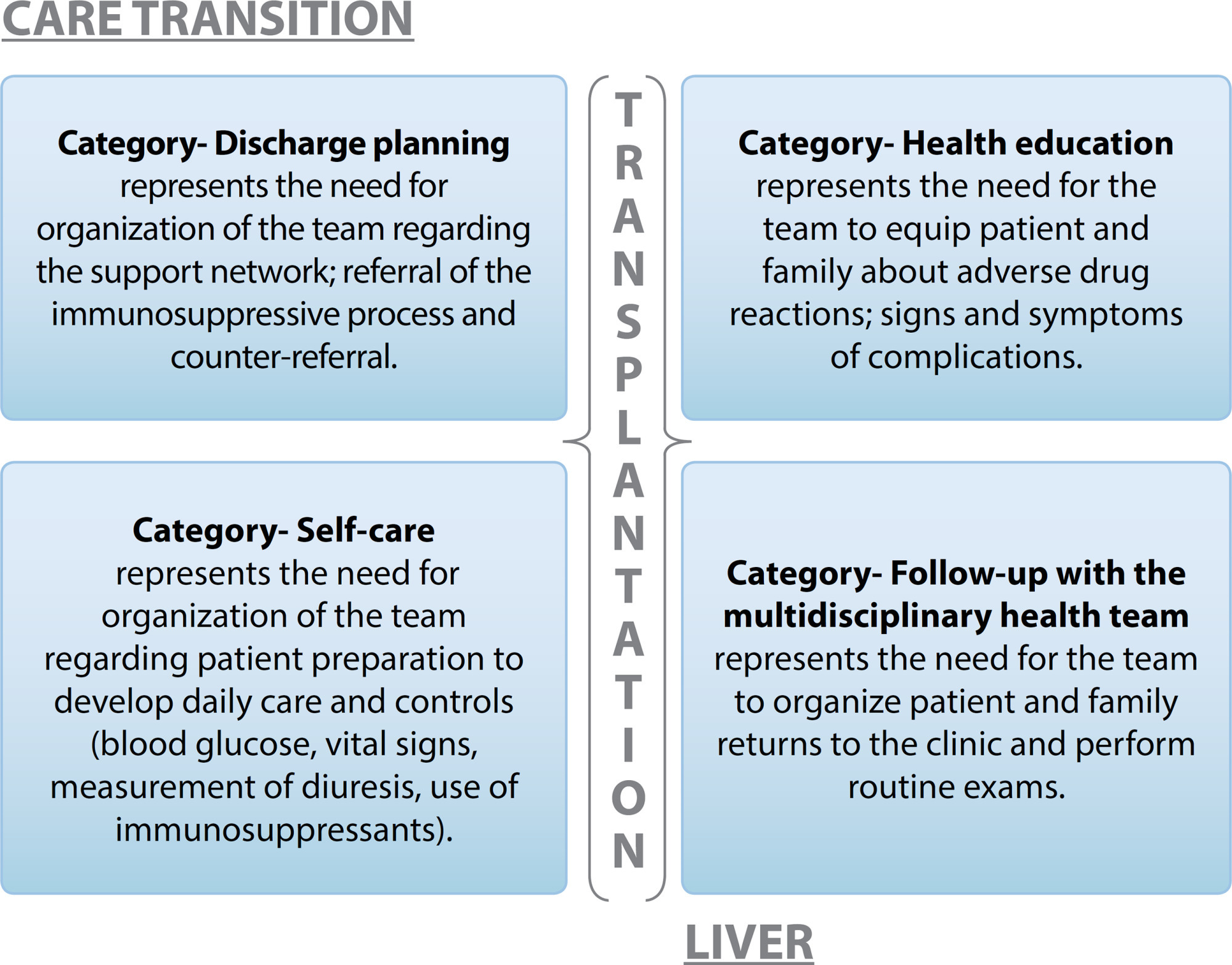
-
ORIGINAL ARTICLE04-22-2022
Development, validation and international certification of a health portal for people with disabilities
Revista Brasileira de Enfermagem. 2022;75:e20210082
Abstract
ORIGINAL ARTICLEDevelopment, validation and international certification of a health portal for people with disabilities
Revista Brasileira de Enfermagem. 2022;75:e20210082
DOI 10.1590/0034-7167-2021-0082
Views0See moreABSTRACT
Objectives:
to develop, validate with specialists and internationally certify a virtual health portal, the D+Informação.
Methods:
a quantitative methodological study. Twenty-two expert judges validated the Portal in the health and computer science areas using the Content Validity Index and the Gwet test. International certification followed HONcode principles® to ensure the trust of information.
Results:
judges of health and computer science validated the portal obtaining a minimum Content Validity Index in more than 75% of the topics, in addition to the evaluation of general agreement, 0.253; content evaluation, 0.193, and interface evaluation, 0.230. All presented the value of Gwet with p ≤ 0,001.
Conclusions:
the portal D+Informação was developed, validated, internationally certified and is hosted on this website:
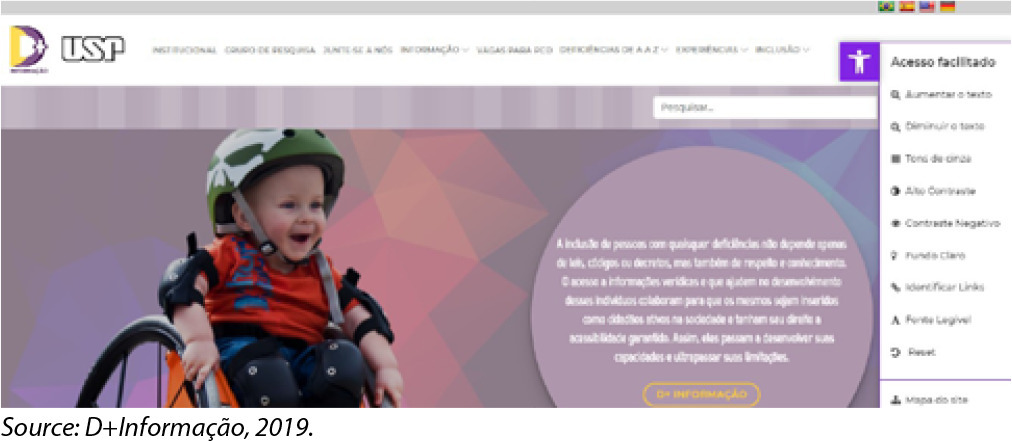
-
REVIEW05-21-2021
Integrative review on the incidence of HIV infection and its socio-spatial determinants
Revista Brasileira de Enfermagem. 2021;74(2):e20200905
Abstract
REVIEWIntegrative review on the incidence of HIV infection and its socio-spatial determinants
Revista Brasileira de Enfermagem. 2021;74(2):e20200905
DOI 10.1590/0034-7167-2020-0905
Views0See moreABSTRACT
Objectives:
to identify the socio-spatial determinants associated with the incidence of infection by the human immunodeficiency virus (HIV) described in national and international literature.
Methods:
integrative literature review that included original articles indexed in the LILACS, PUBMED, CINAHL, and Scopus databases, from 2015 to 2019. The synthesis of the articles was done in a descriptive manner in two categories according to the type of approach.
Results:
13 articles were selected, with a predominance of ecological studies. Regions with deficient access to health services, high population density, higher rates of poverty, intense migratory flow, border areas, as well as precarious socioeconomic conditions, and risk behaviors are associated with higher rates of infection.
Final Considerations:
the influence of regional inequalities on the incidence of HIV infection is revealed, confirming the relevance of spatial analysis techniques for mapping the distribution of diseases and identifying risk areas.

Search
Search in:
Nuvem de Tags
Adolescente (85) Atenção Primária à Saúde (239) COVID-19 (91) Criança (91) Cuidados de Enfermagem (269) Educação em Enfermagem (151) Educação em Saúde (139) Enfermagem (930) Enfermagem Pediátrica (86) Estudantes de Enfermagem (77) Estudos de Validação (131) Família (87) Idoso (208) Promoção da Saúde (99) Qualidade de Vida (104) Saúde do Trabalhador (86) Saúde Mental (145) Saúde Pública (82) Segurança do Paciente (150) Tecnologia Educacional (100)



